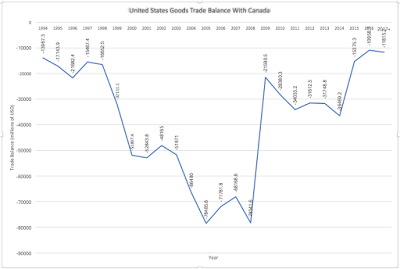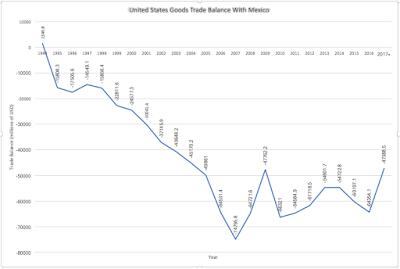
This article was last updated on April 16, 2022
Canada: ![]() Oye! Times readers Get FREE $30 to spend on Amazon, Walmart…
Oye! Times readers Get FREE $30 to spend on Amazon, Walmart…
USA: ![]() Oye! Times readers Get FREE $30 to spend on Amazon, Walmart…
Oye! Times readers Get FREE $30 to spend on Amazon, Walmart…
With Canada, Mexico and the United States renegotiating the 1994 North American Free Trade Act (NAFTA), a look at the trade balance between the three nations is in order, particularly trade between Canada and the United States and Mexico and the United States. For the purposes of this posting, I am sourcing the trade data from the United States Census Bureau with the Canadian trade data sourced here and the Mexican trade data sourced here.
Let’s start with Canada. According to the Office of the United States Trade Representative, we find the following:
– United States exports to Canada are up 165 percent from 1993 (pre-NAFTA).
– United States exports to Canada make up 18.3 percent of America’s overall exports (2015)
– two-way trade in goods with Canada totalled an estimated $544 billion in 2016, making Canada the largest goods trading partner with the United States.
– in 2016, the U.S. goods trade deficit with Canada was $12.1 billion and the services trade surplus was $24.6 billion resulting in an overall trade surplus of $12.5 billion for the United States.
– the U.S. Department of Commerce estimates that American exports of goods and services to Canada supported an estimated 1.6 million jobs in the United States in 2015 (latest data available)
– the top exports to Canada include vehicles, machinery, electrical machinery, mineral fuel and plastics.
– the top imports from Canada include vehicles, mineral fuels, machinery, special other items and plastics.
Here is a graph showing what has happened to the net value (exports minus imports) of American goods exported to Canada since NAFTA was signed:
As you can see, the Great Recession had a profound impact on the American long-term trade deficit with Canada and, in fact, at just under $11 billion, the trade deficit with Canada in 2016 was the smallest since before NAFTA was signed. In fact, in April 2016, the United States ran a trade surplus of $1.13 billion with Canada, the largest monthly trade surplus by a wide margin since prior to 1985.
Now, let’s look at Mexico. Again, according to the Office of the United States Trade Representative, we find the following:
– United States exports to Mexico are up 455 percent from 1993 (pre-NAFTA).
– United States exports to Mexico make up 15.9 percent of America’s overall exports (2015).
– two-way trade in goods with Mexico totalled an estimated $525.1 billion in 2016, with Mexico being America’s second largest export market and second largest supplier of goods imports in 2016.
– in 2016, the U.S. goods trade deficit with Mexico was $63.2 billion and the services trade surplus was $7.6 billion resulting in an overall trade deficit of $55.6 billion for the United States.
– the U.S. Department of Commerce estimates that American exports of goods and services to Mexico supported an estimated 1.2 million jobs in the United States in 2015 (latest data available).
– top exports to Mexico included machinery, electrical machinery, vehicles, mineral fuels and plastics.
– Mexico is the third largest market for U.S. exports of agricultural products.
– top imports from Mexico include vehicles, electrical machinery, machinery, optical and medical instruments and furniture and bedding.
– Mexico is the largest supplier of agricultural products imported into the United States.
Here is a graph showing what has happened to the net value (exports minus imports) of Mexican goods imported into the United States since NAFTA was signed:
As you can see, the Great Recession put an end to the substantial growth rate of the U.S. – Mexico trade deficit; since 2007 when the deficit peaked at nearly $75 billion, the deficit has ranged from a low of $47.7 billion in 2009 to a high of $64.5 billion in 2011.
By way of comparison and to put the data for Canada and Mexico into perspective, let’s look at trade with China. Again, according to the Office of the United States Trade Representative, we find the following:
– United States exports to China are up 504 percent and imports are up 353 percent from 2001 (pre-WTO Accession).
– U.S exports to China make up 8.0 percent of America’s overall exports (2015).
– two-way trade in goods with China totalled an estimated $578.6 billion in 2016 with China being America’s America’s third largest export market and largest supplier of goods in 2016.
– in 2016, the U.S. goods trade deficit with China was $347 billion and the services trade surplus was $37.4 billion resulting in an overall trade deficit of $309.6 for the United States.
– the U.S. Department of Commerce estimates that American exports of goods and services to China supported an estimated 911,000 jobs in the United States in 2015 (latest data available).
While there have been some trade imbalances, trade disagreements and unintended consequences to the implementation of the NAFTA deal, overall and particularly in the case of Canada, the trade situation between the three nations readjusted during and after the Great Recession with the trade deficit with Canada shrinking markedly and the significant annual growth rate of the trade deficit with Mexico levelling off. In any case, it is quite clear that the United States is not suffering from its trade relationship with Canada and Mexico to the same degree that it is experiencing trade imbalance with China whose trade surplus with the United States is 5.5 times that of Mexico. My suspicion is that trade with China will be next on Washington’s agenda.
Click HERE to view more.
You can publish this article on your website as long as you provide a link back to this page.



Be the first to comment